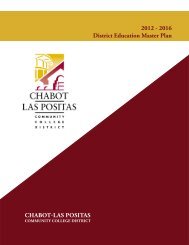City College of San Francisco - California Competes
City College of San Francisco - California Competes
City College of San Francisco - California Competes
You also want an ePaper? Increase the reach of your titles
YUMPU automatically turns print PDFs into web optimized ePapers that Google loves.
STANDARD III.D<br />
The lagging state and local economy yielded<br />
insufficient revenues for the <strong>College</strong> during<br />
fiscal years 2002-03 and 2003-04, requiring the<br />
<strong>College</strong> to implement strategic spending reductions,<br />
including: negotiating a two-year wage<br />
freeze for all employees; reducing spending for<br />
supplies, maintenance, and equipment; reducing<br />
the number <strong>of</strong> classes <strong>of</strong>fered during the summer<br />
term by approximately 50 percent; and reducing<br />
the number <strong>of</strong> classes <strong>of</strong>fered during the fall<br />
and spring semesters by approximately 4 percent.<br />
[Ref. 1] All reductions in revenue and<br />
spending were discussed in multiple venues<br />
such as <strong>College</strong> Council, the Department Chairs<br />
Council, the Chancellor’s Cabinet, the Planning<br />
and Budgeting Council, and Board <strong>of</strong> Trustees’<br />
public meetings. The cooperative negotiations<br />
that allowed these decisions to be implemented<br />
were absolutely critical for ensuring the <strong>College</strong>’s<br />
financial stability. At the same time, these reductions<br />
in both planned and actual spending<br />
were constructed in a manner that allowed the<br />
<strong>College</strong> to maintain its core educational <strong>of</strong>ferings<br />
and student services. Furthermore, increased<br />
and sometimes heroic efforts by faculty and staff<br />
combined with the increased use <strong>of</strong> technology<br />
resulted in more students enrolled and served<br />
in 2003-04 than any prior year. [Ref. 10]<br />
In anticipation <strong>of</strong> reductions in state funding<br />
for 2002-03, the <strong>College</strong> intentionally built its<br />
Board Designated Reserve up to a level <strong>of</strong> $5.5<br />
million by the end <strong>of</strong> 2001-02. During the two<br />
succeeding fiscal years (2002-03 and 2003-04),<br />
the <strong>College</strong>, in a planned manner, used a portion<br />
<strong>of</strong> its Board Designated Reserve to fill the gap<br />
between revenue and expenditures. As a result,<br />
the Board Designated Reserve was lowered from<br />
$5.5 million on June 30, 2002 to $3.775 million<br />
as <strong>of</strong> June 30, 2004. 1 [Ref. 11] The <strong>College</strong>’s<br />
objective is and has been to try to maintain a<br />
5 percent available unrestricted general fund balance<br />
as recommended by the State Chancellor’s<br />
Office. The <strong>College</strong>’s careful approach to budgeting<br />
is reflected in the <strong>College</strong>’s bond ratings<br />
for the September 2004 sale <strong>of</strong> $110 million in<br />
General Obligation Bonds. Both Moody’s and<br />
Standard & Poor’s rated the <strong>College</strong> more favorably<br />
than the <strong>City</strong> and County <strong>of</strong> <strong>San</strong> <strong>Francisco</strong>.<br />
[Ref. 12]<br />
During fiscal year 2004-05, the <strong>College</strong> resumed<br />
paying salary increases to its workforce, including<br />
both step increases for eligible employees as<br />
well as a 4 percent across-the-board increase for<br />
all employees. The <strong>College</strong> also began rebuilding<br />
the number <strong>of</strong> class sections it <strong>of</strong>fers during the<br />
summer semester. At the same time, the cost to<br />
the <strong>College</strong> for providing fringe benefits to its<br />
workforce increased substantially, particularly<br />
in the areas <strong>of</strong> health insurance and retirement.<br />
During the same time period, the <strong>College</strong> witnessed<br />
a significant decline in one <strong>of</strong> its larger<br />
revenue sources, non-resident tuition, and the<br />
<strong>College</strong> did not reach its enrollment growth cap,<br />
resulting in no basic skills funds. The combination<br />
<strong>of</strong> these factors led to a dramatic decline in<br />
the “unreserved undesignated ending balance”<br />
which dropped from $3.5 million to about<br />
$660,000 on June 30, 2005.<br />
To balance its 2005-06 budget, the <strong>College</strong><br />
needed to include the transfer <strong>of</strong> an additional<br />
$800,000 from the Board Designated Reserve,<br />
lowering the expected amount that would<br />
remain in the reserve as <strong>of</strong> June 30, 2006 to<br />
$2.975 million. Other one-time measures taken<br />
to balance the 2005-06 budget provided more<br />
than $1 million in relief. To ensure its long-term<br />
fiscal stability, the <strong>College</strong> needs to develop<br />
and implement a comprehensive plan to<br />
match ongoing spending with ongoing revenue.<br />
Therefore the <strong>College</strong>’s Planning and Budget<br />
Council will be reviewing proposals for ongoing<br />
savings during the Fall 2005 semester in<br />
anticipation <strong>of</strong> the need to reduce spending<br />
during the 2006-07 fiscal year.<br />
The <strong>College</strong> covers its property and liability<br />
insurance needs through its membership in the<br />
Statewide Association <strong>of</strong> Community <strong>College</strong>s<br />
(SWACC), a joint powers authority. The <strong>College</strong><br />
retains the first $25,000 <strong>of</strong> liability for each<br />
claim and is covered by SWACC for the balance<br />
<strong>of</strong> any claim. SWACC in turn is a member <strong>of</strong> the<br />
School Excess Liability Fund (SELF), a larger joint<br />
powers authority. SWACC also sells a portion <strong>of</strong><br />
its risk to reinsurance firms. Through a combination<br />
<strong>of</strong> SELF membership and reinsurance, the<br />
<strong>College</strong> has coverage for claims up to $16 million<br />
for liability and $150 million for property<br />
damage. [Ref. 13]<br />
1 This figure does not include $2.4 million in rents collected from District-owned properties.<br />
CITY COLLEGE OF SAN FRANCISCO<br />
211







